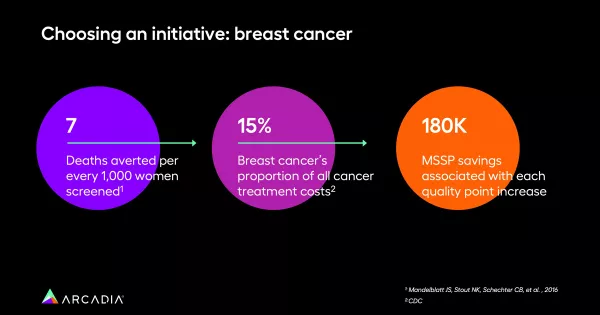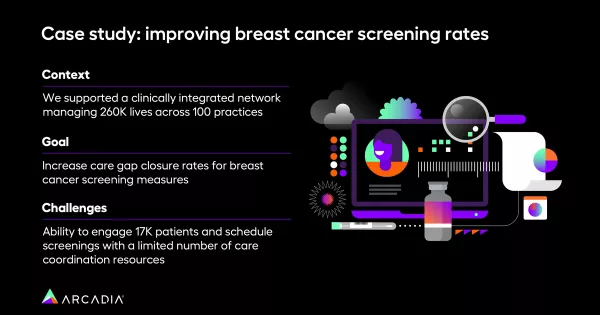From dialing to dynamic: Engage your patient population, hands-free
Enable automatic, large-scale, campaign-driven patient messaging
We’re in a time where patients almost always outnumber staff, which is why it’s imperative to find ways to streamline care opportunities. This way, patients can receive the best care they need. Here, we explore how Arcadia’s patient engagement tools can automate workloads, free up staff resources, and provide better outcomes for patients.
Key features and benefits of patient engagement tools include:
- Care gap-driven campaigns — Full integration with Arcadia cohorts and care gaps for automating quality improvement
- AI engine integration — Programmable outreach based on robust rules engine of patient identification, automated to shape future touchpoints around previous interactions
- Care coordination at scale — Expanded reach to hundreds of thousands of lower risk patients while enabling clinical staff to focus on highly impactable patients
With a case study on breast cancer screening as their driving initiative, they saw astounding results.
Choosing an initiative: Breast cancer
Breast cancer screening is a prime example of the impact patient engagement can have on healthcare by averting 7 deaths per every 1,000 women screened. The CDC reports that breast cancer accounts for 14% of all cancer treatment costs, making it a significant financial burden. Embracing patient engagement tools can lead to substantial savings, such as the $180K MSSP savings associated with each quality point increase.

With patient engagement tools, we not only save lives but also reduce the financial burden of breast cancer, making healthcare more effective and cost-efficient.
Case study: Improving breast cancer screening rates
Let's delve into a real-world case study with Arcadia’s patient engagement tools.
“One of our customers was able to leverage our product to message many patients at once and try to get them into the office to close those gaps,” says Kate Brind, Arcadia Senior Product Manager.

In this case, Arcadia supported a clinically integrated network managing 260,000 lives across 100 practices. The goal was to increase care gap closure rates for breast cancer screening measures, a challenging task considering the need to engage 17,000 patients and schedule screenings with limited care coordination resources.
Let’s break down how the program was designed, how the patients were stratified, and the results of the study.
Program design: Strategic implementation
The CIN aimed to reach 17,000 patients to close gaps, but they had limited care coordination resource. The success of this initiative started with a strategic implementation:
- Patients were stratified into cohorts
- Text messages were delivered over a span of 9 months
- Patients scheduled mammograms
- Breast cancer screening gaps were closed systematically
Patient stratification: Targeted engagement
“The patient stratification piece is really important here because we are able to dynamically stratify patients into cohorts and into programs,” says Brind. “We’re not sifting through patients manually, we’re able to identify them quickly send them a message when they are eligible for that program, and try to get them into the office to close that gap.”

Effective patient engagement requires the right message to reach the right patients. In this case, the focus was on all patients:
- Non-compliant for HEDIS breast cancer screening measure during the calendar year
- With active eligibility for Medicare and commercial LOBs
- Functionally attributed to a PCP in the network
Measuring success: Program results
The results spoke volumes about the effectiveness of patient engagement tools in closing care gaps:
- 13,000 messages delivered, out of 17,000 messages attempted
- 79% successful delivery rate
- 20% gap closure rate for messaged patients within 12 months
The CIN also saw high successful delivery rates as well as gap closure by dynamically stratifying those patients, reaching out to them over time, and closing those gaps with that low touch resource.
From dialing to dynamic: Data and analytics propel better patient care
Patient engagement tools are a catalyst for transforming healthcare. From automating care gap-driven campaigns to harnessing the power of AI for programmable outreach, and expanding care coordination at scale.
If you're ready to empower your organization with data-driven, patient-centric solutions, schedule a consultation with Arcadia. Let's work together to shape a healthcare landscape where patients receive the attention and care they deserve.
